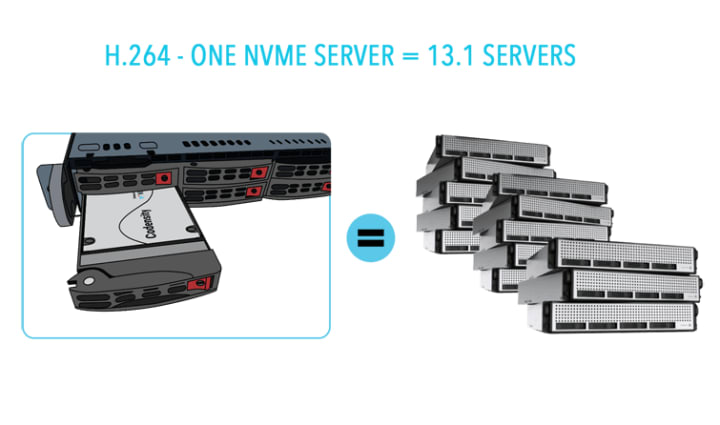When Google announced the ASIC-based Argos VCU in 2021, the trade press rightfully applauded. CNET announced that "Google supercharges YouTube with a custom video chip." Ars Technica reported that Argos brought " up to 20–33x improvements in compute efficiency compared to… running software on traditional servers." SemiAnalysis reported that Argos "Replaces 10 Million Intel CPUs."
Of course, here at NETINT, none of these benefits were particularly surprising. We've been shipping ASIC-based transcoders since 2019. And while our transcoders have a different focus than Argos - we do live, they do VOD - we've been delivering the same performance improvements and savings to our customers since we started shipping. In fact, In 2021 NETINT customers encoded 200 billion minutes using our ASIC-based transcoding units.
Unlike Argos, you can actually buy Quadra units to "supercharge" your own applications
We're currently shipping our fifth generation Quadra video processing unit (VPU) technology, which can transcode 1x 8Kp60/4x 4Kp60/16x 1080p60 in real-time. Unlike Argos, Quadra encodes AV1, along with HEVC and H.264. Also, unlike Argos, you can actually buy Quadra units to "supercharge" your own applications. If you only need H.264 and HEVC, check out the T408 for a lower price point.
The bottom line is that if you're producing live or interactive events on a large scale, you should check our ASIC-based encoders. While we can't promise to replace 10 million Intel CPUs, the 20–33x improvement in computing efficiency is right in our wheelhouse.

Dense is good when it comes to transcoding
Back in high school, if someone called you dense, it meant you were slow on the uptake, and it definitely wasn’t a compliment. For high-volume video transcoding, however, density is, without question, a major plus.
Some background. NETINT designs, develops, and sells ASIC-powered transcoders like the T408 and T432, which can output H.264 and HEVC, and the Quadra, which produces H.264, HEVC, and AV1. These transcoders are available in multiple form factors including U.2 and PCIe add-in cards. The U.2 modules fit into slots in rack-mounted servers like that shown in Figure 1, with some servers having the capacity for over 20 NVMe devices.

Once installed, each T408 serves as a self-contained encoding engine, requiring little more from the host server other than handing live streams to the T408 and delivering the encoded streams to the packaging engine. This standalone transcoding performance maximizes the number of T408s you can install in a server. Think high density!
For example, Table 1 shows H.264 encoding performance with three different systems. On average, encoding utilizing the on-board T408s, the system delivered 4164 frames per second using only 369 watts of power for an FPS/watt of 11.00. In contrast, with software-only encoding with the x264 codec using the Fast preset, the same systems averaged 318 frames per second using 364 watts for an FPS/watt of 87.

If you divide the frames per second produced by the T408 (4164) by the fps produced via software-based encoding (318), you’ll find that it takes about 13.1 servers without the T408s to equal the performance of a single server with between 10–24 T408s. We’ve helpfully presented that in figure 2.
With T408s costing less than $400 at volume and the high-capacity encoding workstation around $12,000 or much higher, it’s easy to see the huge CAPEX advantage to the ASIC-based approach. This is especially true given that for some transcoding applications, you can run ten T408’s on a much less expensive server.
What about OPEX? Oh, there’s an equally impressive advantage here as well. The NETINT-powered encoding system consumes just 7.5% of the power of the software-only approach and better still produces only 7.5% the carbon emissions compared to CPU and software!

Table 2 shows the same computation with HEVC using the x265 Medium preset. Here, you’d need 55.1 standalone systems to produce the same output as the T408-enabled system (we’ll spare you the diagram). Even if you assume a significant speed increase by using a faster x265 preset, the CAPEX, OPEX, and emissions savings delivered by the ASIC-enabled systems are unquestionably quite significant.

What about quality? We’re preparing a more detailed comparison for future presentations demonstrating that NEINT’s ASIC-based transcoders deliver quality equivalent to or better than the software-based codecs/presets typically used for live transcoding.
To be sure, ASIC-based solutions aren’t right for all applications. But if you’re a high-volume live streaming platform or are streaming interactive videos or games, you’d have to be … well, dense … not to consider NETINT transcoders.
Discover more here: https://netint.com/resources/blog/
Follow us on Twitter @NETINT_Tech
#NETINT #Encoding #Condensity #Video #Streaming #LiveStreaming #Quadra
About the Creator
NETINT
NETINT Technologies is a leading innovator in the field of video processing solutions. We specialize in developing ASIC-based (Application Specific Integrated Circuit) solutions for low-latency video transcoding.






Comments
There are no comments for this story
Be the first to respond and start the conversation.